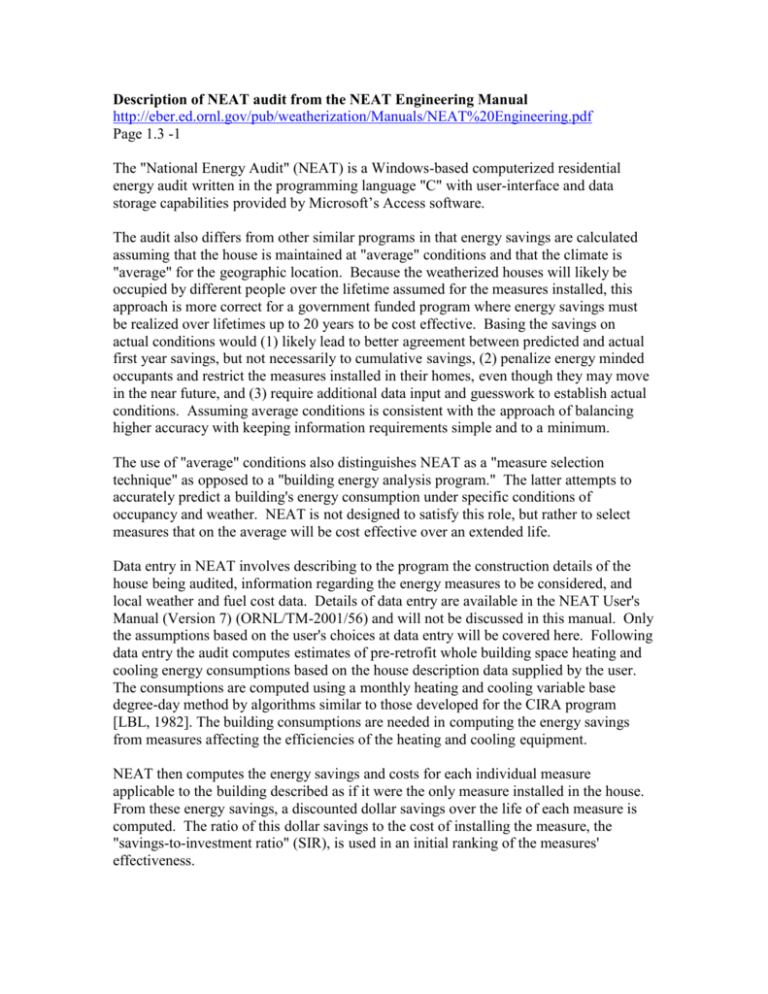Description of NEAT Engineering logic
advertisement

Description of NEAT audit from the NEAT Engineering Manual http://eber.ed.ornl.gov/pub/weatherization/Manuals/NEAT%20Engineering.pdf Page 1.3 -1 The "National Energy Audit" (NEAT) is a Windows-based computerized residential energy audit written in the programming language "C" with user-interface and data storage capabilities provided by Microsoft’s Access software. The audit also differs from other similar programs in that energy savings are calculated assuming that the house is maintained at "average" conditions and that the climate is "average" for the geographic location. Because the weatherized houses will likely be occupied by different people over the lifetime assumed for the measures installed, this approach is more correct for a government funded program where energy savings must be realized over lifetimes up to 20 years to be cost effective. Basing the savings on actual conditions would (1) likely lead to better agreement between predicted and actual first year savings, but not necessarily to cumulative savings, (2) penalize energy minded occupants and restrict the measures installed in their homes, even though they may move in the near future, and (3) require additional data input and guesswork to establish actual conditions. Assuming average conditions is consistent with the approach of balancing higher accuracy with keeping information requirements simple and to a minimum. The use of "average" conditions also distinguishes NEAT as a "measure selection technique" as opposed to a "building energy analysis program." The latter attempts to accurately predict a building's energy consumption under specific conditions of occupancy and weather. NEAT is not designed to satisfy this role, but rather to select measures that on the average will be cost effective over an extended life. Data entry in NEAT involves describing to the program the construction details of the house being audited, information regarding the energy measures to be considered, and local weather and fuel cost data. Details of data entry are available in the NEAT User's Manual (Version 7) (ORNL/TM-2001/56) and will not be discussed in this manual. Only the assumptions based on the user's choices at data entry will be covered here. Following data entry the audit computes estimates of pre-retrofit whole building space heating and cooling energy consumptions based on the house description data supplied by the user. The consumptions are computed using a monthly heating and cooling variable base degree-day method by algorithms similar to those developed for the CIRA program [LBL, 1982]. The building consumptions are needed in computing the energy savings from measures affecting the efficiencies of the heating and cooling equipment. NEAT then computes the energy savings and costs for each individual measure applicable to the building described as if it were the only measure installed in the house. From these energy savings, a discounted dollar savings over the life of each measure is computed. The ratio of this dollar savings to the cost of installing the measure, the "savings-to-investment ratio" (SIR), is used in an initial ranking of the measures' effectiveness. The "interacted" savings and SIR of measures are then determined assuming the measures are added to the house collectively, in order of their ranking, e.g., the second ranked measure is installed in the house initially described by the user after having been modified by the first ranked measure. If this second-ranked measure's updated SIR is greater than a user-defined limit, the measure is left implemented, else it is removed so that the next measure's effectiveness is not dependent on it. The choice between two mutually exclusive measures (such as different levels of insulation) is made on the basis of their "net present value" (NPV), the difference of life-time savings and installation cost, rather than their SIR. This has been shown to be the more correct criterion on which to base the selection between two measures, both of which cannot be installed. The audit computes and reports to the user the energy savings, discounted dollar savings, installation cost, and SIR for each measure considered cost-effective. For those with SIR greater than the user-designated cutoff, a materials list gives the material name, type, and quantity required for installation of the measure. NEAT permits entry of pre-retrofit billing data for gas or electrically heated homes or homes with electric air-conditioning. The user may then make the decision to have the savings of the measures adjusted to reflect the difference in billed consumption and that predicted by the program.










